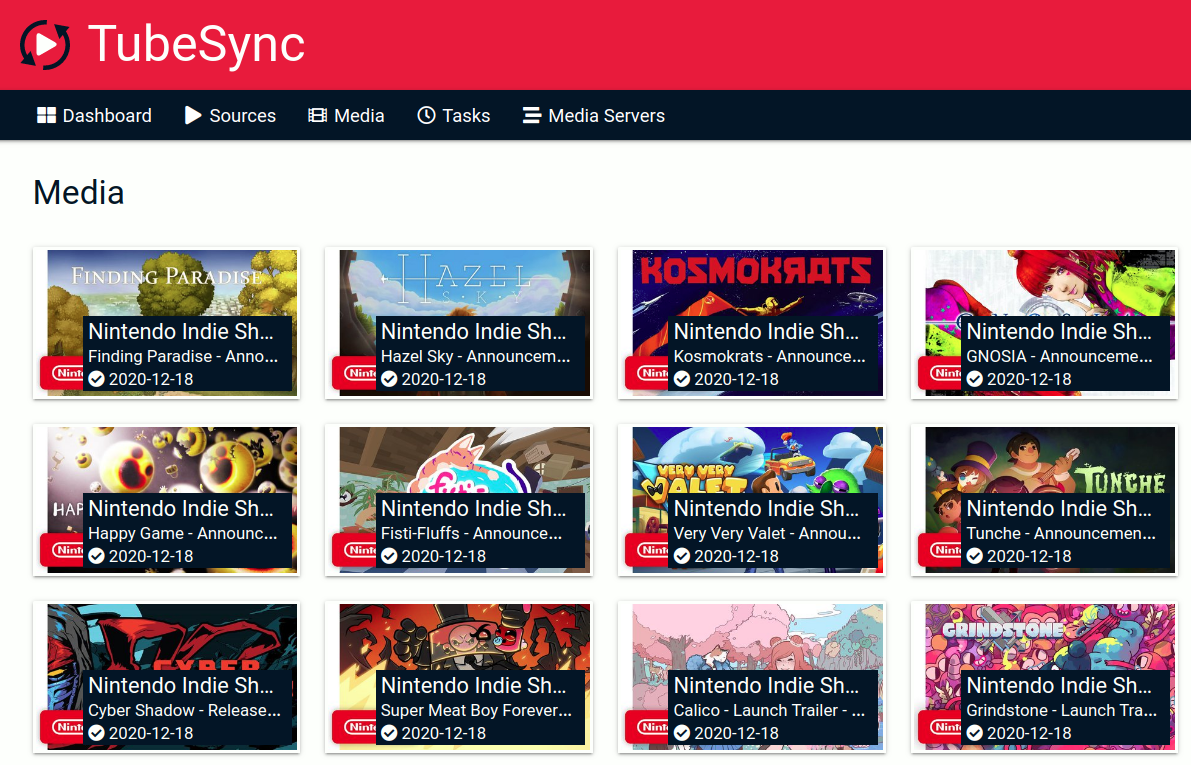
tubesync
- 0 ratings

Syncs YouTube channels and playlists to a locally hosted media server.
Self-host this app for $0.99/mo only!
Depends on a proprietary service outside the user's control
This is a preview release of TubeSync, it may contain bugs but should be usable
TubeSync is a PVR (personal video recorder) for YouTube. Or, like Sonarr but for YouTube (with a built-in download client). It is designed to synchronize channels and playlists from YouTube to local directories and update your media server once media is downloaded.
If you want to watch YouTube videos in particular quality or settings from your local
media server, then TubeSync is for you. Internally, TubeSync is a web interface wrapper
on yt-dlp and ffmpeg with a task scheduler.
There are several other web interfaces to YouTube and yt-dlp all with varying
features and implementations. TubeSync's largest difference is full PVR experience of
updating media servers and better selection of media formats. Additionally, to be as
hands-free as possible, TubeSync has gradual retrying of failures with back-off timers
so media which fails to download will be retried for an extended period making it,
hopefully, quite reliable.
ghcr.io/meeb/tubesync:latest




For the easiest installation, you will need an environment to run containers such as Docker or Podman. You will also need as much space as you want to allocate to downloaded media and thumbnails. If you download a lot of media at high resolutions this can be very large.
Once running, TubeSync will download media to a specified directory. Inside this
directory will be a video and audio subdirectories. All media which only has an
audio stream (such as music) will download to the audio directory. All media with a
video stream will be downloaded to the video directory. All administration of
TubeSync is performed via a web interface. You can optionally add a media server,
currently just Plex, to complete the PVR experience.
TubeSync is designed to be run in a container, such as via Docker or Podman. It also
works in a Docker Compose stack. amd64 (most desktop PCs and servers) and arm64
(modern ARM computers, such as the Rasperry Pi 3 or later) are supported.
Example (with Docker on *nix):
First find the user ID and group ID you want to run TubeSync as, if you're not sure what this is it's probably your current user ID and group ID:
$ id
# Example output, in this example, user ID = 1000, group ID = 1000
# id uid=1000(username) gid=1000(username) groups=1000(username),129(docker)You can find your local timezone name here:
https://en.wikipedia.org/wiki/List_of_tz_database_time_zones
If unset, TZ defaults to UTC.
Next, create the directories you're going to use for config data and downloads:
$ mkdir /some/directory/tubesync-config
$ mkdir /some/directory/tubesync-downloadsFinally, download and run the container:
# Pull image
$ docker pull ghcr.io/meeb/tubesync:latest
# Start the container using your user ID and group ID
$ docker run \
-d \
--name tubesync \
-e PUID=1000 \
-e PGID=1000 \
-e TZ=Europe/London \
-v /some/directory/tubesync-config:/config \
-v /some/directory/tubesync-downloads:/downloads \
-p 4848:4848 \
ghcr.io/meeb/tubesync:latestOnce running, open http://localhost:4848 in your browser and you should see the
TubeSync dashboard. If you do, you can proceed to adding some sources (YouTube channels
and playlists). If not, check docker logs tubesync to see what errors might be
occurring, typical ones are file permission issues.
Alternatively, for Docker Compose, you can use something like:
version: '3.7'
services:
tubesync:
image: ghcr.io/meeb/tubesync:latest
container_name: tubesync
restart: unless-stopped
ports:
- 4848:4848
volumes:
- /some/directory/tubesync-config:/config
- /some/directory/tubesync-downloads:/downloads
environment:
- TZ=Europe/London
- PUID=1000
- PGID=1000Available in v1.0 (or :latest)and later. If you want to enable a basic username and
password to be required to access the TubeSync dashboard you can set them with the
following environment variables:
HTTP_USER
HTTP_PASSFor example, in the docker run ... line add in:
...
-e HTTP_USER=some-username \
-e HTTP_PASS=some-secure-password \
...Or in your Docker Compose file you would add in:
...
environment:
- HTTP_USER=some-username
- HTTP_PASS=some-secure-password
...When BOTH HTTP_USER and HTTP_PASS are set then basic HTTP authentication will be
enabled.
To update, you can just pull a new version of the container image as they are released.
$ docker pull ghcr.io/meeb/tubesync:v[number]Back-end updates such as database migrations should be automatic.
TubeSync, when running in its default container, stores thumbnails, cache and its
SQLite database into the /config directory and wherever you've mapped that to on your
file system. Just copying or moving this directory and making sure the permissions are
correct is sufficient to move, back up or migrate your TubeSync install.
Pick your favourite YouTube channels or playlists, pop over to the "sources" tab, click whichever add button suits you, enter the URL and validate it. This process extracts the key information from the URL and makes sure it's a valid URL. This is the channel name for YouTube channels and the playlist ID for YouTube playlists.
You will then be presented with the initial add a source form where you can select all the features you want, such as how often you want to index your source and the quality of the media you want to download. Once happy, click "add source".
That's about it. All other actions are automatic and performed on timers by scheduled tasks. You can see what your TubeSync instance is doing on the "tasks" tab.
As media is indexed and downloaded it will appear in the "media" tab.
Currently TubeSync supports Plex as a media server. You can add your local Plex server under the "media servers" tab.
TubeSync outputs useful logs, errors and debugging information to the console. You can view these with:
$ docker logs --follow tubesyncOnce you're happy using TubeSync there are some advanced usage guides for more complex and less common features:
It's a good idea to add sources with as long of an index frequency as possible. This is the duration between indexes of the source. An index is when TubeSync checks to see what videos available on a channel or playlist to find new media. Try and keep this as long as possible, up to 24 hours.
If you add a massive (several thousand videos) channel to TubeSync and choose "index every hour" or similar short interval it's entirely possible your TubeSync install may spend its entire time just indexing the massive channel over and over again without downloading any media. Check your tasks for the status of your TubeSync install.
If you add a significant amount of "work" due to adding many large channels you may
need to increase the number of background workers by setting the TUBESYNC_WORKERS
environment variable. Try around ~4 at most, although the absolute maximum allowed is 8.
Be nice. it's likely entirely possible your IP address could get throttled by the source if you try and crawl extremely large amounts very quickly. Try and be polite with the smallest amount of indexing and concurrent downloads possible for your needs.
No, TubeSync is designed to repeatedly scan and download new media from channels or playlists. If you want to download single videos the best suggestion would be to create your own playlist, add the playlist to TubeSync and then add single videos to your playlist as you browse about YouTube. Your "favourites" playlist of videos will download automatically.
At the moment, no. This is a pre-release. The library TubeSync uses that does most
of the downloading work, yt-dlp, supports many hundreds of video sources so it's
likely more will be added to TubeSync if there is demand for it.
No, in fact, there is no JavaScript at all in the web interface at the moment. TubeSync is designed to be more set-and-forget than something you watch download. You can see what active tasks are being run in the "tasks" tab and if you want to see exactly what your install is doing check the container logs.
No, this feature is best served by existing services such as the excellent Tautulli which can monitor your Plex server and send alerts that way.
You only really need to worry about these if there is a permanent failure. Some errors are temporary and will be retried for you automatically, such as a download got interrupted and will be tried again later. Sources with permanent errors (such as no media available because you got a channel name wrong) will be shown as errors on the "sources" tab.
Python3 using Django, embedding yt-dlp. It's pretty much glue between other much larger libraries.
Notable libraries and software used:
s6-init and nginxSee the Pipefile for a full list.
Yes, although pretty much all operations are available through the front-end interface and you can probably break things by playing in the admin. If you still want to access it you can run:
$ docker exec -ti tubesync python3 /app/manage.py createsuperuserAnd follow the instructions to create an initial Django superuser, once created, you can log in at http://localhost:4848/admin
There is support for basic HTTP authentication by setting the HTTP_USER and
HTTP_PASS environment variables. There is not support for multi-user or user
management.
No, you should deploy it behind an HTTPS-capable proxy if you want this (nginx, caddy, etc.). Configuration of this is beyond the scope of this README.
Just amd64 for the moment. Others may be made available if there is demand.
Make sure that you have mysql_config or mariadb_config available, as required by the python module mysqlclient. On Debian-based systems this is usually found in the package libmysqlclient-dev
There are a number of other environment variables you can set. These are, mostly, NOT required to be set in the default container installation, they are really only useful if you are manually installing TubeSync in some other environment. These are:
| Name | What | Example |
|---|---|---|
| DJANGO_SECRET_KEY | Django's SECRET_KEY | YJySXnQLB7UVZw2dXKDWxI5lEZaImK6l |
| DJANGO_URL_PREFIX | Run TubeSync in a sub-URL on the web server | /somepath/ |
| TUBESYNC_DEBUG | Enable debugging | True |
| TUBESYNC_WORKERS | Number of background workers, default is 2, max allowed is 8 | 2 |
| TUBESYNC_HOSTS | Django's ALLOWED_HOSTS, defaults to * |
tubesync.example.com,otherhost.com |
| TUBESYNC_RESET_DOWNLOAD_DIR | Toggle resetting /downloads permissions, defaults to True |
True |
| GUNICORN_WORKERS | Number of gunicorn workers to spawn | 3 |
| LISTEN_HOST | IP address for gunicorn to listen on | 127.0.0.1 |
| LISTEN_PORT | Port number for gunicorn to listen on | 8080 |
| HTTP_USER | Sets the username for HTTP basic authentication | some-username |
| HTTP_PASS | Sets the password for HTTP basic authentication | some-secure-password |
| DATABASE_CONNECTION | Optional external database connection details | mysql://user:pass@host:port/database |
As a relatively normal Django app you can run TubeSync without the container. Beyond following this rough guide, you are on your own and should be knowledgeable about installing and running WSGI-based Python web applications before attempting this.
pipenv installtubesync/tubesync/local_settings.py.example to
tubesync/tubesync/local_settings.py and edit it as appropriate./manage.py migrate./manage.py collectstaticgunicorn pointing it to the application
in tubesync/tubesync/wsgi.pynginx and forward it to the WSGI server./manage.py process_tasks as the background task worker to index and download
media. This is a non-detaching process that will write logs to the console. For long
term running you could use a terminal multiplexer such as tmux, or create
systemd unit to run it.There is a moderately comprehensive test suite focusing on the custom media format matching logic and that the front-end interface works. You can run it via Django:
$ ./manage.py test --verbosity=2All properly formatted and sensible pull requests, issues and comments are welcome.
Please login to review this project.
No reviews for this project yet.
Comments (0)
Please login to join the discussion on this project.